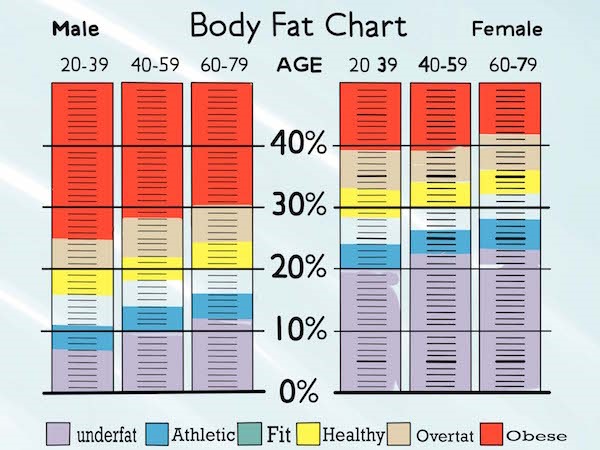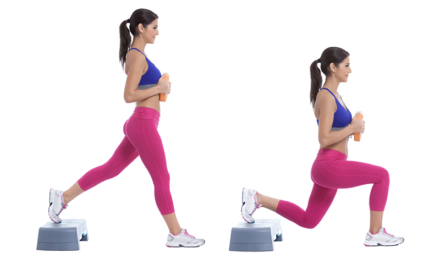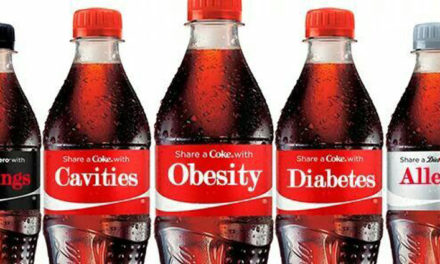Good morning everyone and as always, happy Thursday.
So last week we delved into the Body Mass Index, more commonly known as BMI, and discussed what BMI is, how you calculate it, what you use it for and most importantly, the major issue with using BMI as an indicator of health.
Today, as I promised last week, I am going to talk about body fat percentage, what it is, what it tells us about our body and our health, why it is a much better metric to use than BMI, and how to calculate it.
But before we talk about body fat percentage, let’s very quickly outline the negative role that body fat plays on the body and to our health.
What is the correlation between body fat and health?
Fat tissue, scientifically known as adipose tissue, was once thought to be an inactive and harmless type of body tissue disliked (hated really) because of its negative impact on looks.
But recently the scientific community has found that body fat is actually a biologically active tissue that releases hormones that impact hunger and metabolism.
Additionally, individuals with high to extremely high levels of body fat are at a higher risk for cardiovascular disease, heart failure, diabetes, and metabolic syndrome. There is also some evidence correlating high levels of body fat with certain types of cancers.
So with these new discoveries in mind it is now clearer than ever that maintaining a healthy level of body fat is essential to maintaining our overall health.
So what is “body fat percentage”?
“Body fat percentage” is a term, which references the measurement of the amount of your weight that is made up exclusively of fat tissue, as opposed to other types of tissues such as bones, organs and muscles.
How do you measure body fat?
The gold standard method for measuring body fat is known as the DEXA body scan. Very long story made short, is the DEXA scanner scans your body very much like an X-Ray to determine your body fat percentage and where your body fat is located.
The big pro to the DEXA body scan is that it is the most accurate way to measure your body fat percentage. The negative is that you need to go to a doctor to get it done, there aren’t actually that many DEXA body scans around, and it costs roughly $300 per scan.
Below is a Website link to the one place here in Manhattan, which I know that does DEXA body scans:
The most popular way to measure body fat is by using skin calipers, pinching the skin at key points of the body, measuring the amount of fat deposited at those sites, adding up the measurements and inputting the total into a chart which will then tell you your corresponding body fat percentage.
The pro to this method is that that skin calipers cost about $10-$15 and are portable and easy to use.
The negative is that studies have shown that due to a number of factors, there is a high variance of results when using skin calipers and skin fold measurements.
The method I use with my clients most often is to use a hand held body fat measuring machine. Long story short this machine sends electronic impulses into your hands (No it does not electrocute you) and measures how long the impulses take to come back.
This method is relatively accurate, inexpensive, and easy.
The image below goes to a Website link to the most popular hand held body fat machine I know of:

What is considered a healthy body fat percentage?
What is considered a healthy level of body fat depends on your gender and age, but the following is a solid chart that details healthy and unhealthy body fat percentages for men and women of various ages. (*One important note; women naturally have a higher body fat percentage than men as a result of hormonal differences and as a preparatory measure for pregnancy.)

And here is a second chart that puts body fat into more of a visual representation:

Why body fat percentage is a much more accurate health metric than BMI?
Body fat percentage is a significantly more accurate measurement of health over that of BMI because body fat percentage only counts fat mass as unhealthy weight, unlike BMI, which counts muscle, bones and organs as potentially unhealthy weight.
This is critical because, as we established last week, high levels of muscle mass have a profoundly positive impact on our health, our healthy hormones levels, our metabolism, our strength, our balance and our joint health.
As such, you must have a metric that differentiates between unhealthy fat mass, and extremely healthy muscle mass (and absolutely vital structures like freaking bones and organs!!!)
Losing weight should really be called losing fat.
In addition to knowing your body fat percentage in order to gain accurate insight into your overall health, if you are trying to lose weight it also becomes essential to know your body fat percentage.
Why?
Because when you are trying to “lose weight” what you are actually trying to do is lose as much unhealthy and unsightly body fat as possible. And to do this as efficiently as possible you’ll also want to maintain as much muscle mass as possible.
Why?
Because, as we discussed earlier, muscle mass keeps your healthy hormones and metabolism high, not to mention muscle is what gives your body an aesthetically pleasing shape and tone.
If you simply rely on your scale during your weight loss journey you won’t be able to tell if you are losing just fat or both fat and muscle. But, if you also track your body fat percentage you can adjust your workout and dietary program accordingly to ensure you are maximizing your fat loss while minimizing your muscle loss.
Okay that’s it for today and our lesson on the importance of knowing your body fat percentage.
Until next time and as always,
To our health!
Zach




